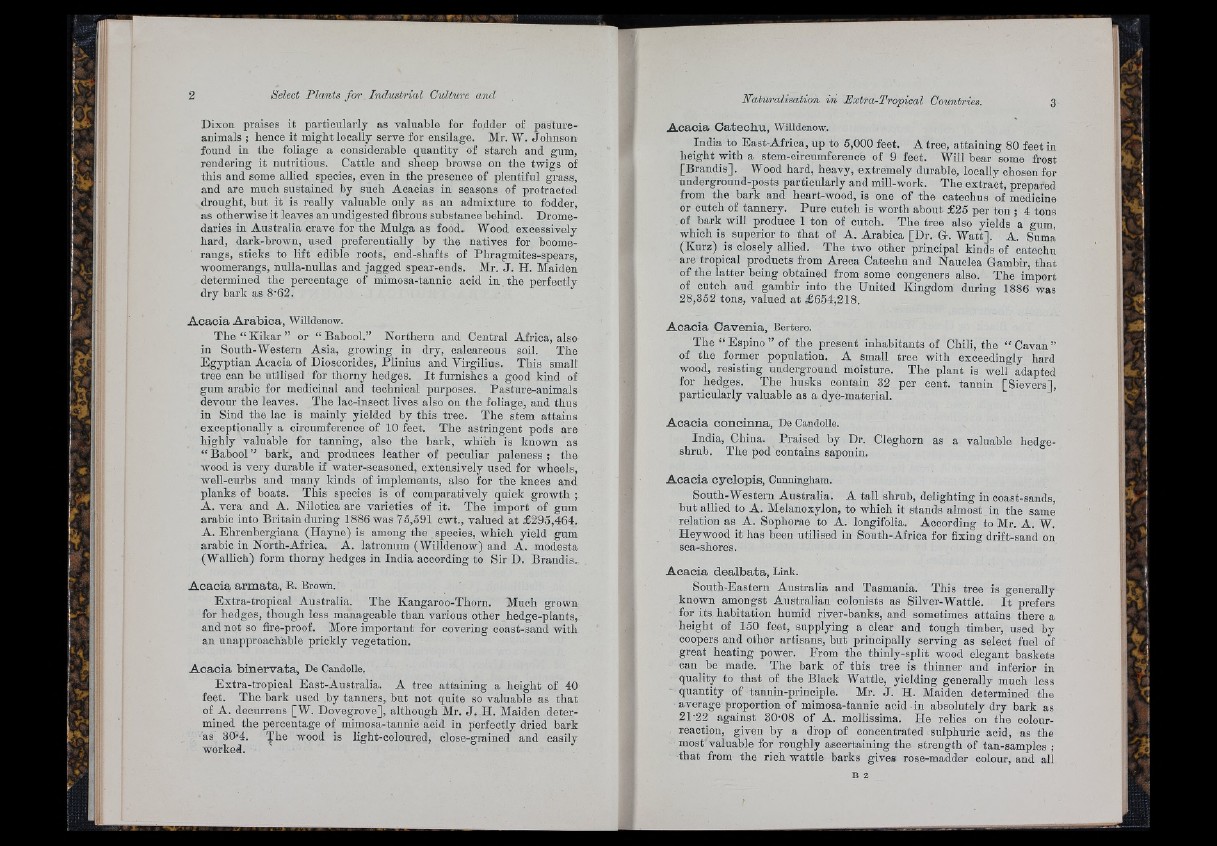
Dixou praises it particularly as valuable for fodder of pasture-
animals ; hence it might locally serve for ensilage. Mr. W. Johnson
found in the foliage a considerable quantity of starch and gum,
rendering it nutritious. Cattle and sheep browse on the twigs of
this and some allied species, even in the presence of plentiful grass,
and are much sustained by such Acacias in seasons of protracted
drought, but it is really valuable only as an admixture to fodder,
as otherwise it leaves an undigested fibrous substance behind. Dromedaries
in Australia crave for the Mulga as food. Wood excessively
hard, dark-brown, used preferentially by the natives for boomerangs,
sticks to lift edible roots, end-shafts of Phragmites-spears,
woomerangs, niilla-nullas and jagged spear-ends. Mr. J . H. Maiden
determined the percentage of mimosa-tannic acid in the perfectly
dry bark as 8'62.
A c a c ia A ra b ic a , Willdenow.
The “ Kikar ” or “ Babool.” Northern and Central Africa, also
in South-Western Asia, growing in dry, calcareous soil. The
Egyptian Acacia of Dioscorides, Plinius and Virgilius. This small
tree can be utilised for thorny hedges. I t furnishes a good kind of
gum arable for medicinal and technical purposes. Pasture-animals
devour the leaves. The lac-insect lives also on the foliage, and thus
in Sind the lac is mainly yielded by this tree. The stem attains
exceptionally a circumference of 10 feet. The astringent pods are
highly valuable for tanning, also the hark, which is known as
“ Babool ” bark, and produces leather of peculiar paleness ; the
wood is very durable if water-seasoned, extensively used for wheels,
well-cnrbs and many kinds of implements, also for the knees and
planks of boats. This species is of comparatively quick growth ;
A. vera and A. Nilotica are varieties of it. The import of gum
arable into Britain during 1886 was 75,591 cwt., valued a t £295,464.
A. Ehrenbergiana (Hayne) is among the species, which yield gum
arable in North-Africa. A. latronnm (Willdenow) and A. modesta
(Wallich) form thorny hedges in India according to Sir D. Brandis.
A c a c ia a rm a ta , R. Brown.
Extra-tropical Australia. The Kangaroo-Thorn. Much grown
for hedges, though less manageable than various other hedge-plants,
and not so fire-proof. More important for covering coast-sand with
an unapproachable prickly vegetation.
A c a c ia b in e rv a ta , De Candolle.
Extra-tropical East-Australia. A tree attaining a height of 40
feet. The hark used by tanners, but not quite so valuable as th a t
of A. decurrens [W. Dovegrove], although Mr. J . H. Maiden determined
the percentage of mimosa-tannic acid in perfectly dried bark
as 30-'4. The wood is light-coloured, close-grained and easily
worked.
A c a c ia C a te c h u , Willdenow.
India to East-Africa, up to 5,000 feet. A tree, attaining 80 feet in
height with a stem-oircumference of 9 feet. Will bear some frost
[Brandis]. Wood hard, heavy, extremely durable, locally chosen for
underground-posts particularly and mill-work. The extract, prepared
from the bark and heart-wood, is one of the catechus of medicine
or outch of tannery. Pure cutch is worth about £25 per ton ; 4 tons
of bark will produce 1 ton of cutch. The tree also yields a gum,
which is superior to th a t of A. Arabica [Dr. G. Watt]. A. Suma
(Kurz) is closely allied. The two other principal kinds of catechu
are tropical products from Areca Catechu and Nauclea Gambir, that
of the latter being obtained from some congeners also. The import
of cutch and gambir into the United Kingdom during 1886 was
28,352 tons, valued a t £654,218.
A c a c ia C a v e n ia , Bertero.
The “ Espino ” of the present inhabitants of Chili, the “ Cavan ”
of the former population. A small tree with exceedingly hard
wood, resisting underground moisture. The plant is well adapted
for hedges. The husks contain 32 per cent, tannin [Sievers],
particularly valuable as a dye-material.
A c a c ia o o n c in n a , De Candolle.
India, China. Praised by Dr. Cleghorn as a valuable hedge-
shrub. The pod contains saponin.
A c a c ia cy c lo p is, Cunningham.
South-Western Australia. A tall shrub, delighting in ooast-sands,
but allied to A. Melauoxylon, to which it stands almost in the same
relation as A. Sophorae to A. longifolia. According to Mr. A. W.
Heywood it has been utilised in South-Africa for fixing drift-sand on
sea-shores.
A c a c ia d e a lb a ta , Link.
South-Eastern Australia and Tasmania. This tree is generally
known amongst Australian colonists as Silver-Wattle. I t prefers
for its habitation humid river-banks, and sometimes attains there a
height of 150 feet, supplying a clear and tough timber, used by
coopers and other artisans, but principally serving as select fuel of
great heating power. From the thinly-split wood elegant baskets
can be made. The bark of this tree is thinner and inferior in
quality to th a t of the Black Wattle, yielding generally much less
quantity of tannin-principle. Mr. J . H. Maiden determined the
average proportion of mimosa-tannic acid in absolutely dry bark as
21-22 against 30-08 of A. mollissima. He relies on the colour-
reaotion, given by a drop of concentrated sulphuric acid, as the
most valuable for roughly ascertaining the strength of tan-samples ;
th a t from the rich wattle barks gives rose-madder colour, and all